By Kathryn Miles
Photographed by Mark Fleming
From our November 2019 issue
[cs_drop_cap letter=”I” color=”#000000″ size=”10em” ]t’s a temperate Thursday morning in Georgetown, near the mouth of the Kennebec River, and fisheries scientist Marissa McMahan, of the nonprofit conservation and research foundation Manomet, is wobbling on a floating dock, instructing a small troop of volunteers. The crew is surrounded by massive gray lobster crates and more 10-gallon buckets than I can count. Inside both, thousands of green crabs click and creep and skitter.
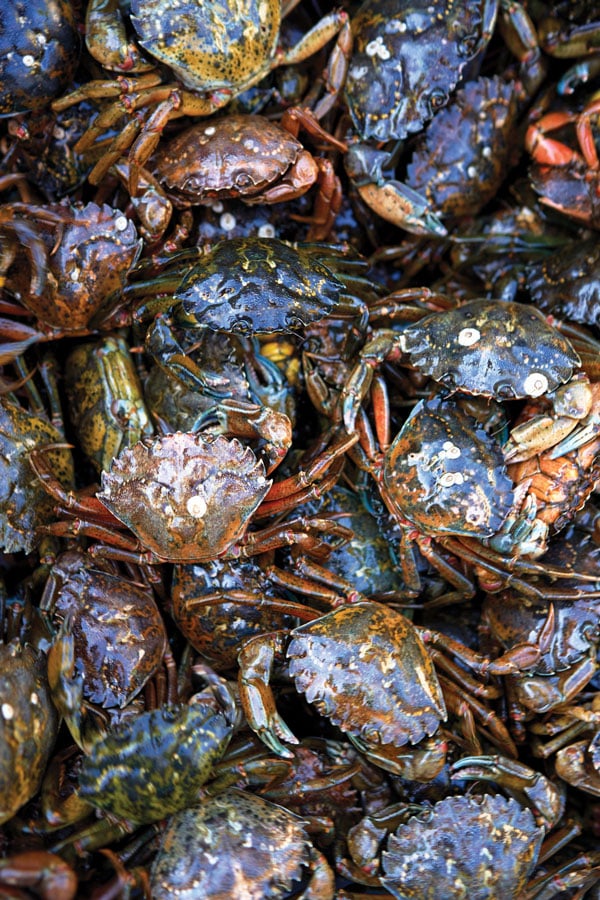 “These little bastards are mean,” volunteer Kate MacKay warns me, using one of the gentler words I’ve heard to describe the decapods. “They’re just mad all of the time.”
“These little bastards are mean,” volunteer Kate MacKay warns me, using one of the gentler words I’ve heard to describe the decapods. “They’re just mad all of the time.”
From one of the teeming lobster crates, MacKay yanks a green crab about the size of her hand. She counts its legs and claws, then records its diameter and color (not all, or even most, green crabs are actually green) before tossing it into another crate and reaching down to repeat the process.
McMahan looks on and snickers. The fisheries division director for the Massachusetts- and Brunswick-based Manomet, she’s been pinched by her share since beginning her research on this invasive species about four years ago, while working on her dissertation at Northeastern University. She too has been known to use some blue language to describe green crabs — and the more she studies them, the less she likes them.
Carcinus maenas arrived on the U.S. Atlantic coast from southwestern Europe and the Mediterranean in the early 19th century, hidden in ship ballast and bilge water. For nearly 200 years, Maine’s brutal winters kept populations down. But steadily rising ocean temperatures have caused an explosion in the state’s green crab population. Turn over any rock on Maine’s coast and you’re likely to find a few juveniles, each no bigger than a quarter. Farther out at sea, green crabs as big as the ones MacKay is handling are invading lobster traps and decimating clam populations.
McMahan wants to know just how bad this problem has gotten — and she wants to solve it. She’s explaining the intricacies of crab mating to me as Maine game warden Doug Kulis putters up to us in a skiff. Another of McMahan’s volunteers, he’s arriving with his weekly contribution to her population study. The night before, following her instruction, he placed a single redfish head in a lobster trap and sank it in the marsh behind his house. When he pulled the trap this morning, it had more than 100 crabs in it — a fairly typical overnight catch, Kulis says. Those crabs are now in buckets on the floor of his boat. The warden grunts as he hauls them onto the float. A bucketful of these bastards is heavy.
If you wanted to make a sci-fi movie about a single species’ terrifying quest for global domination, you could pick a worse subject than Carcinus maenas.
After McMahan and her volunteers log the new arrivals, she dumps about 30 of them into an oversize shopping bag and hands it to me.
“If you can’t beat ’em, eat ’em,” McMahan says, and she recites a broth recipe I’ve agreed to make in exchange for the ecology lesson.
One look in that bag, though, and I want to renege. Turns out a teeming bag of invasive green crabs is pretty gross. But at the risk of spoilers, let me tell you: they are also surprisingly tasty. And McMahan and others hope that single fact can help save the Gulf of Maine.
[inpost_leaderboard_middle_1]
[cs_drop_cap letter=”F” color=”#000000″ size=”5em” ]ew heralded food scenes are as connected to place as ours is to the Gulf of Maine and its watershed. The problem is, nearly everything about that place is changing — and at an unprecedented rate. Right now, the Gulf of Maine is warming about seven times faster than the rest of the world’s oceans, according to Andy Pershing, chief scientific officer at the Gulf of Maine Research Institute. That trend, along with decades of overfishing in our waters, is beginning to mandate a new food paradigm.
Maine once supplied canned sardines to the world. In 2010, its last sardine cannery closed, and today, the Atlantic States Marine Fisheries Commission enforces strict limits on Atlantic herring, the fish that once filled those cans. The same is true for keystone fish like cod and halibut. More recently, a combination of aggressive catches and warming ocean waters has depleted shrimp stocks here, spurring the same commission to close Maine’s shrimp fishery entirely until at least 2021.
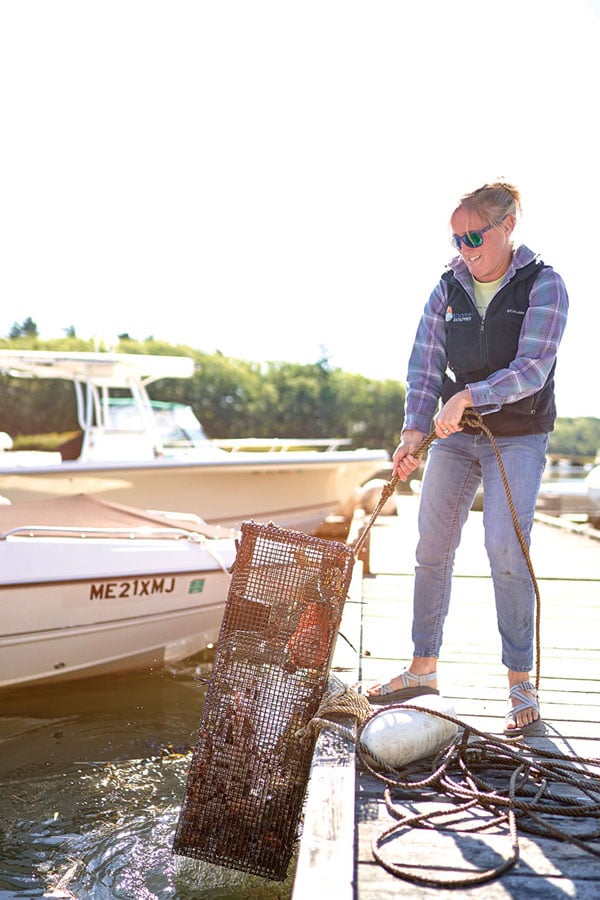

In response, the state has tried hard to regulate these and other fisheries. The Department of Marine Resources, for instance, has limited the growth of lobstering with quotas and license limits. Each of the state’s seven lobster zones now fiercely regulates the number of active permits and traps allowed. In some zones, 4,000 traps must be hung up before a new license can be issued. In the region that includes Georgetown, five lobstermen need to retire before a prospective one can get a new license. (Game warden Kulis has been on the wait list for over a decade — there’s still one hopeful ahead of him. McMahan threw her name in the hat in 2013. She’s 10th on the list, making it all but mathematically impossible that she’s ever handed a tag.)
The system, strict as it may seem, has successfully safeguarded the state’s most valuable industry, Pershing says. But he adds that the same warming waters that helped contribute to the collapse of our shrimp industry are also creating unexpected challenges for other fisheries, including lobster. In 2012, marine heat waves created a huge spike in early soft-shell lobsters that overwhelmed dealers and processers; that, in turn, caused prices to plummet. The boom in lobster populations has continued since, but it has also shifted progressively Down East. Eventually, Pershing says, lobster populations may shift so far northeast that they depart U.S. waters altogether. Meanwhile, experts have documented a decline in baby and juvenile lobsters in the Gulf of Maine, and many worry the drop in those numbers may hasten a collapse of the fishery here.
 Other valuable shellfish face similar challenges. Already, changing weather patterns and increased precipitation are forcing more fresh water into the gulf, and that increase is carrying more organic run-off into our ocean waters. Both factors elevate the gulf’s acidity. That, Pershing says, makes it harder for shellfish like mussels and oysters to form their shells and maintain healthy population numbers.
Other valuable shellfish face similar challenges. Already, changing weather patterns and increased precipitation are forcing more fresh water into the gulf, and that increase is carrying more organic run-off into our ocean waters. Both factors elevate the gulf’s acidity. That, Pershing says, makes it harder for shellfish like mussels and oysters to form their shells and maintain healthy population numbers.
The changing Gulf of Maine is a phenomenon that Sam Hayward, owner and James Beard Award–winning executive chef at Portland’s Fore Street, knows all too well. Long before he was a nationally recognized leader in the sustainable food movement, Hayward was a de facto student of the Gulf of Maine, working his first cooking job at the Shoals Marine Laboratory on Appledore Island. There, fishermen would deliver him 40-pound cod with stomachs filled with baby lobsters. The island’s pigs, kept there as living composters, would regularly escape their pens and hightail it to the intertidal zone to eat their weight in the abundant mussels there. Hayward took it all in — the fishermen’s catch, the cod diets, the availability of the shellfish, and he formed his culinary aesthetic around it.
Those massive cod are long gone now, Hayward says. And he hasn’t seen a mussel out on the Shoals in a long time. But he does see plenty of green crabs, along with other new species like squid and black sea bass. The question now, he says, is what to do with them.
Pershing agrees. “We’re watching this cold-water ecosystem transition into something else,” he says. “That’s no longer in doubt. The only thing that remains to be seen is whether that transition is going to happen smoothly or in a messy way because things are happening too quickly.”
Both Pershing and Hayward would like to see policies that promote a sustainable fishery for emerging species like the squid and sea bass. If properly managed, these new arrivals can fill the niche left by colder-water fish like haddock and halibut.
“They’re the golden fleece of local seafood,” Mallett says. “everyone who has ordered them here has absolutely loved them.”
“These are species that have the natural potential to move into our ecosystem without running roughshod over it,” Pershing says. “We can allow fishermen to profit from them while also maintaining the health of the ecosystem.”
But the green crabs, he says, are a different kind of arrival entirely.
[inpost_leaderboard_middle_2]
[cs_drop_cap letter=”I” color=”#000000″ size=”5em” ]f you wanted to make a sci-fi movie about a single species’ terrifying quest for global domination, you could pick a worse subject than Carcinus maenas. Even understated scientists can’t seem to resist hyperbole when describing them. They’ve been called “ravenous predators” and “one of the worst alien species in the world.” Scholarly articles describe them as crushing their foes (of which there are many — green crabs feast on prey from at least 158 genera, according to several studies). They have obliterated entire shellfish communities (a single adult green crab can eat up to 50 mollusks a day, including clams, mussels, and oysters). They have single-handedly decimated the soft-shell clam industry in the Gulf of Maine. In Connecticut, they’ve unleashed 70 percent mortality rates on scallop beds. Throughout all of New England, they’ve destroyed eelgrass beds and caused massive marshland erosion.
What’s more, green crabs are virtually indestructible. They couldn’t care less about salinity and are just as happy in a river mouth as in the saltiest bay. They are comfortable in a wide range of water temperatures — anywhere from zero to 35 degrees Celsius and probably beyond. (McMahan once left a bucket of them in her barn on a winter night. She found them frozen solid the next morning. As the day warmed, they thawed out and reanimated themselves, like little arthropod zombies.) Green crabs can live for days without water and even longer without food. They are prolific breeders and have virtually no predators, save for the few brazen gulls willing to grab them.
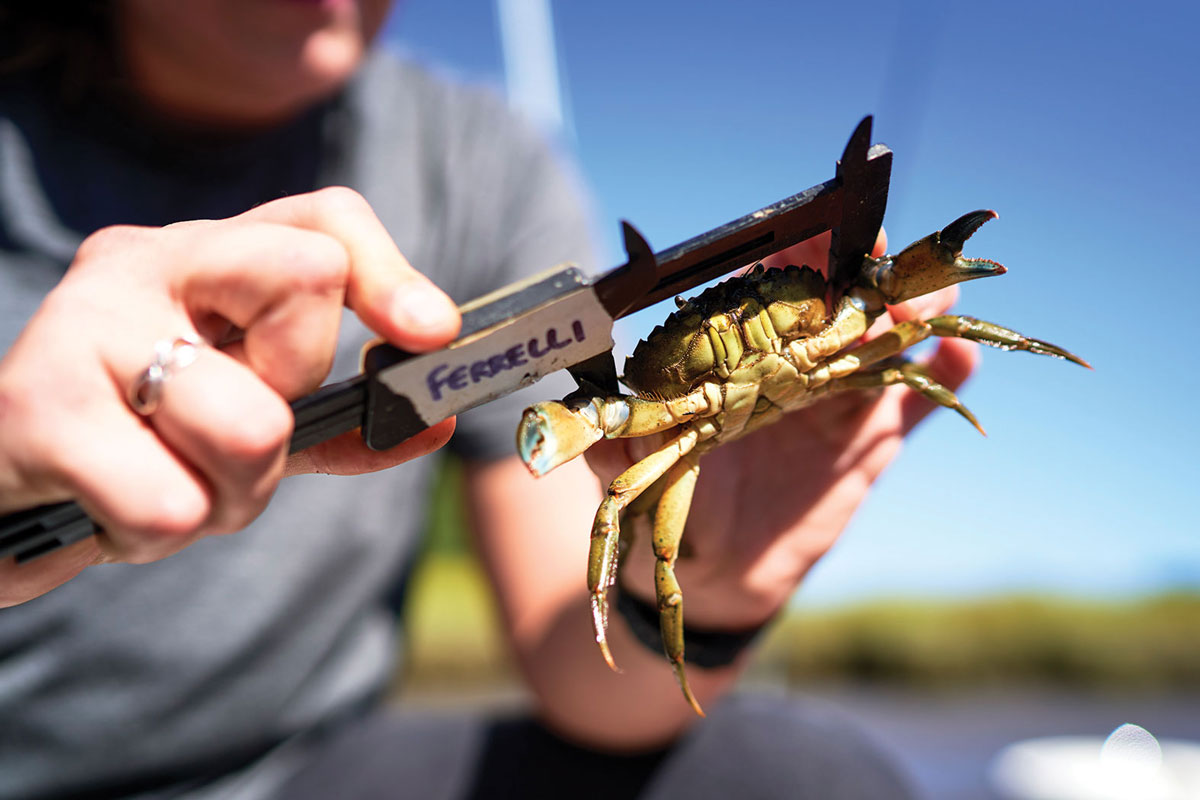
In 2014, then-governor Paul LePage issued an executive order identifying Carcinus maenas as a voracious nuisance. But crabs don’t read, and they’ve kept on multiplying and engorging themselves and generally acting like very expensive pests, undermining what LePage’s order called a $25 million bivalve industry.
Since then, scientists at nonprofits and universities in Maine and New England have received grant money for wide-ranging pilot programs aimed at reducing green crab populations. They’ve tried making them into fertilizer. Dog food. Lobster bait. Some promising initiatives have emerged, but none has done much to reduce populations. And so, in Maine, the green crab remains public enemy number one.
But in southern European waters, where green crabs are native, it’s a very different story.
Like other crustaceans, green crabs molt once a year. Each spring, the females lose their hard shells. In the early autumn, the males take a turn. And in both seasons, the entire soft-shell crab is edible. Crab fishermen have been pulling them out of Venice’s lagoon for generations. They’re known as moeche on menus there, says celebrity chef and Venice native Enrica Rocca. And they’re to die for.
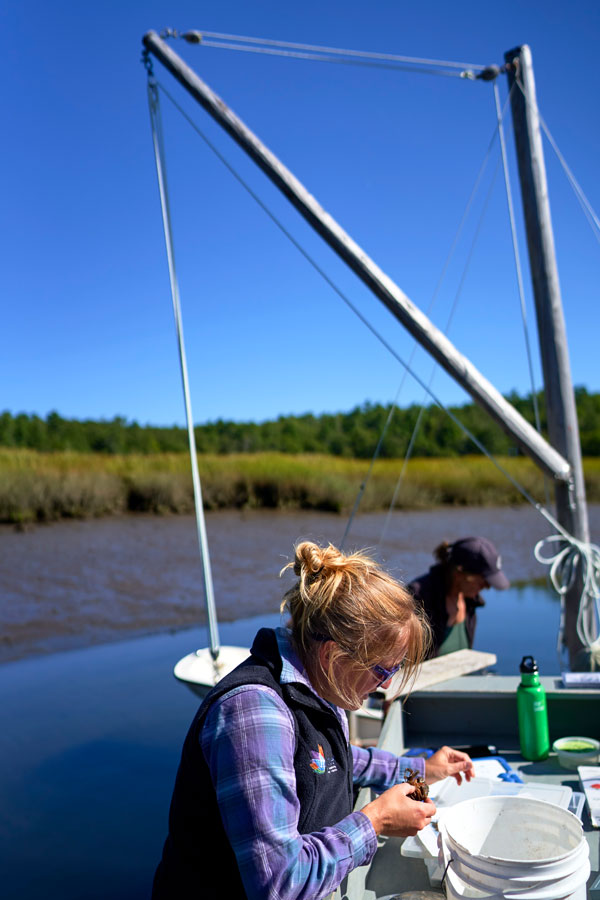 In Venice, Rocca says, the traditional preparation for moeche is to take a half-dozen live soft-shell crabs and let them hang out in an egg batter for a few hours (Rocca calls this “their last meal”). Then, chefs dust the crabs with flour and deep-fry them. They’re served with a sprinkling of salt, sometimes a lemon wedge, and always with a glass of prosecco or another crisp white wine. Gastrotourists plan their visits to Venice around the arrival of moeche on menus there. A single small plate can easily set them back 25 euros — well worth paying, Rocca says.
In Venice, Rocca says, the traditional preparation for moeche is to take a half-dozen live soft-shell crabs and let them hang out in an egg batter for a few hours (Rocca calls this “their last meal”). Then, chefs dust the crabs with flour and deep-fry them. They’re served with a sprinkling of salt, sometimes a lemon wedge, and always with a glass of prosecco or another crisp white wine. Gastrotourists plan their visits to Venice around the arrival of moeche on menus there. A single small plate can easily set them back 25 euros — well worth paying, Rocca says.
“They’re delicious. They’re fabulous. They cost a fortune, and they’re totally worth it.”
Even after the soft-shell phase, Rocca and other Venetians still go out of their way to put green crabs on their tables. She likes the hard-shells roasted whole and sprinkled with rosemary. She’ll heap a platter full and set them out, hot out of the oven, so guests can gather to suck the meat out of the shells. It’s peasant food, she says, and a ton of fun — like throwing peanut shells on the floors of accommodating restaurants.
A few years ago, Georgetown resident Jonathan Taggart experienced this culinary phenomenon firsthand. An art conservator by trade, Taggart was in Venice for a working vacation and fell in love with moeche and other green crab variations. A few months later, he ran into McMahan at a Christmas party on the midcoast. He can’t recall whether it was the prosecco or the merriment or something McMahan said. Either way, he had an epiphany: if Venetians have fostered a huge green crab fishery, why couldn’t Mainers?
McMahan and Taggart joined up with Gabriela Bradt, a fisheries specialist at the University of New Hampshire Cooperative Extension and New Hampshire Sea Grant, and Boston-based writer Roger Warner, and together they launched the Green Crab R&D Project, a nonprofit working to develop culinary markets for green crab. Bradt and McMahan also hosted the first multi-day Green Crab Working Summit, held in Portland in 2018. Speakers and participants included scientists, educators, and chefs like Ali Waks Adams, of Brunswick’s Daniel Hotel and Coast Bar + Bistro, who served up sample dishes of green crab Rangoon and bouillabaisse, handing out recipes to anybody who’d take them.
“It’s a broken system. And we have to fix it. I want to be as loud a voice as I can here.” — Chef Evan Mallet
In Georgetown, McMahon enlisted recreational fishermen like Kulis and professional lobstermen like her partner, Christopher Jamison, to start trapping them. They apprenticed themselves to Venetian crabbers, who taught them how to sort hard shells from soft shells and keep the latter from eating one another — the answer involves tiny crab condos made out of scallop netting.
That kind of Yankee ingenuity, McMahan and Taggart say, is just what makes the possibility of a green crab fishery so appealing. Even if someone like McMahan were to live long enough to see a lobster license, that privilege comes with annual fees as high as $880, not to mention thousands of dollars in gear expenses. A commercial green crab license costs a Maine resident $10. All the disused gear once employed in the Maine shrimp industry makes for great crab traps. And Jamison says there are plenty of used lobster crates and other accessories to make entry into a green crab fishery accessible for novices and kids looking to dip their toes into the fishing life.
[inpost_leaderboard_middle_3]
In 2018, Jamison became the first person in the U.S. to catch and market soft-shell green crabs, selling directly to restaurants. Taggart continues to work with fishermen on developing affordable gear, and he’s a tireless media mouthpiece for the nascent industry. In August, the two of them received a 2019 Gulf of Maine Council Visionary Award for their efforts to establish a viable green crab fishery.
The recognition is nice, Taggart says, but for him, it was never the point. “I didn’t set out to be a crab fisherman,” he jokes. “I just wanted to order them on a Maine menu.”
And for that to happen, he and others need to make sure you want them too.
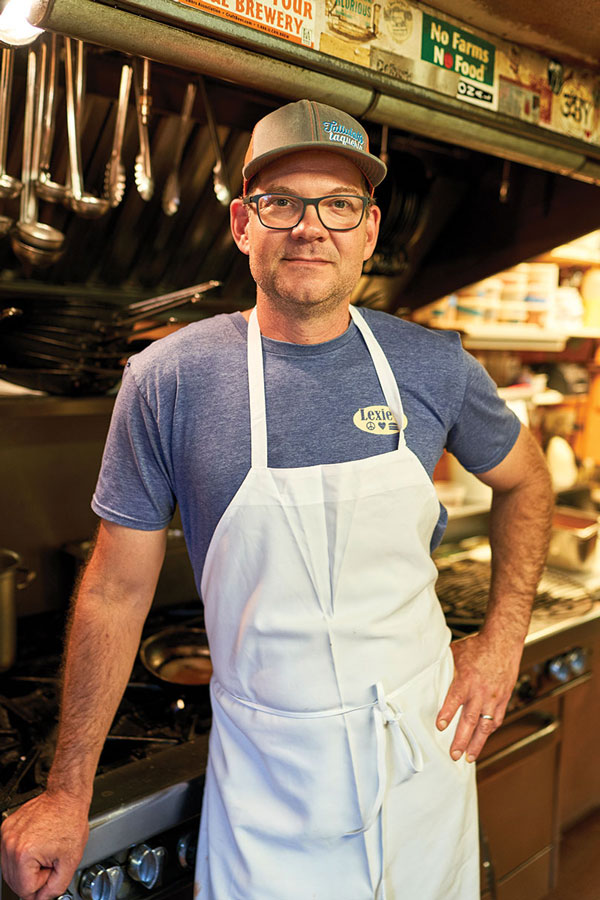
[cs_drop_cap letter=”O” color=”#000000″ size=”5em” ]ne of New England’s earliest green crab adopters was Evan Mallett, a Berwick resident, cookbook author, and chef-owner of Black Trumpet bistro in Portsmouth, New Hampshire. (From 2017 through last winter, he also ran Ondine Oyster + Wine Bar in Belfast.) As Mallett came of age as a chef, inspired by Sam Hayward and other slow-food devotees, he found himself increasingly worried about our food systems, particularly where seafood is concerned.
Each year, the U.S. exports more than 1.2 million metric tons of seafood, and some 90 percent of the seafood we eat comes from overseas, where it was either caught or processed. That struck Mallett as a big problem. When he opened Black Trumpet in 2007, he committed to regional sourcing for all of the restaurant’s fish. Rhode Island squid seemed like a sound choice, until he read the fine print and learned that the cephalopods, which may indeed have been caught nearby, were then frozen in large blocks, shipped to China for processing, and returned in tidy packages — a round trip that took them over 13,000 miles.
“It’s a broken system,” Mallett says. “And we have to fix it. I want to be as loud a voice as I can here.”
So Mallett began looking for truly local solutions. He and his wife, Denise, began an heirloom vegetable garden to stock their restaurant. He contracted with a local rod-and-reel fisherman for fairly caught seafood. And he’d already been foraging green crabs on his own, so he says it was a “natural segue” when Bradt approached him one day with a basket of commercially harvested soft-shells.
“They’re the golden fleece of local seafood,” Mallett says. “Everyone who has ordered them here has absolutely loved them.”
Mallett prefers riffing on the Venetian recipe. He likes dredging the tiniest green crabs in cornmeal, then dropping them hot oil. The result is something like a very briny, very tasty potato chip. You can make them at home if you harvest your own. (Be sure to consult state laws regarding harvesting and tread gingerly through the intertidal ecosystem.)
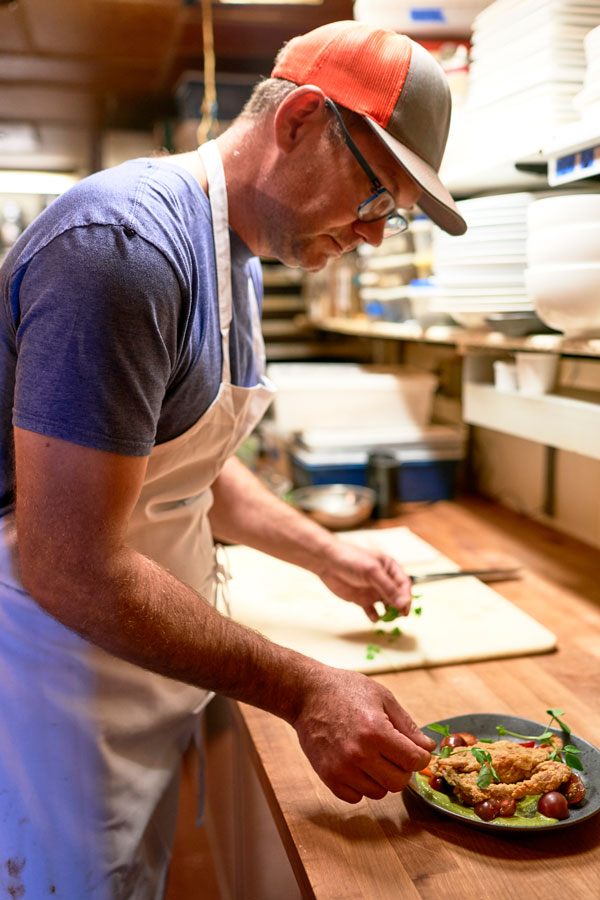

My partner swears he hates crab, but he loved the fried little guys. He also liked the broth I promised McMahan I’d make. I used my pressure cooker and experimented, first with whole crabs, then just legs and claws. Both were good, though the former was more flavorful and also a bit muddy — best as a base for something like paella. We both adored our homemade moeche, devouring it in less time than it took to write this paragraph.
This summer, Mallett was one of five chefs, including Brunswick’s Waks Adams, to participate in the first-ever Green Crab Week, when restaurants in Maine, Massachusetts, New Hampshire, and NYC offered nightly green crab specials. (Waks Adams served hers in a beer batter with shishito peppers; Mallett opted for a seared tuna topped with coconut green-crab bisque.) But outside of such special events, it’s too soon to walk into a restaurant and expect to find green crabs on the menu. While chefs might love to feature the little guys, there’s just no infrastructure in place to ensure the supply a restaurant like Black Trumpet or Fore Street would need. Changing that, the chefs say, is up to diners.
“We won’t have a dependable supply until we have a dependable demand,” Hayward says. “If you ask for them, we can make them fly out of the kitchen.”
Waks Adams agrees. She’s been working with McMahan and others to develop recipes for green crabs that work both in Maine restaurants and at home. In the meantime, she’s thinking big. She’d like to see the state generating enough crab broth, for instance, to supply to the giant soup companies. And she’s currently working on a grant to experiment with fish sauce production using fermented green crabs. That too, she reminds, will require buy-in from consumers.
“At the end of the world, there’s going to be nothing left but cockroaches and green crabs unless we start getting rid of them in bulk,” she warns. “You want to save the planet? You want to do your job as a Maine eater? Start eating these little f**kers. It’s what we all need to do.”
Chef Evan Mallett’s Masa-Crusted Soft-Shell Crab with Mole Verde
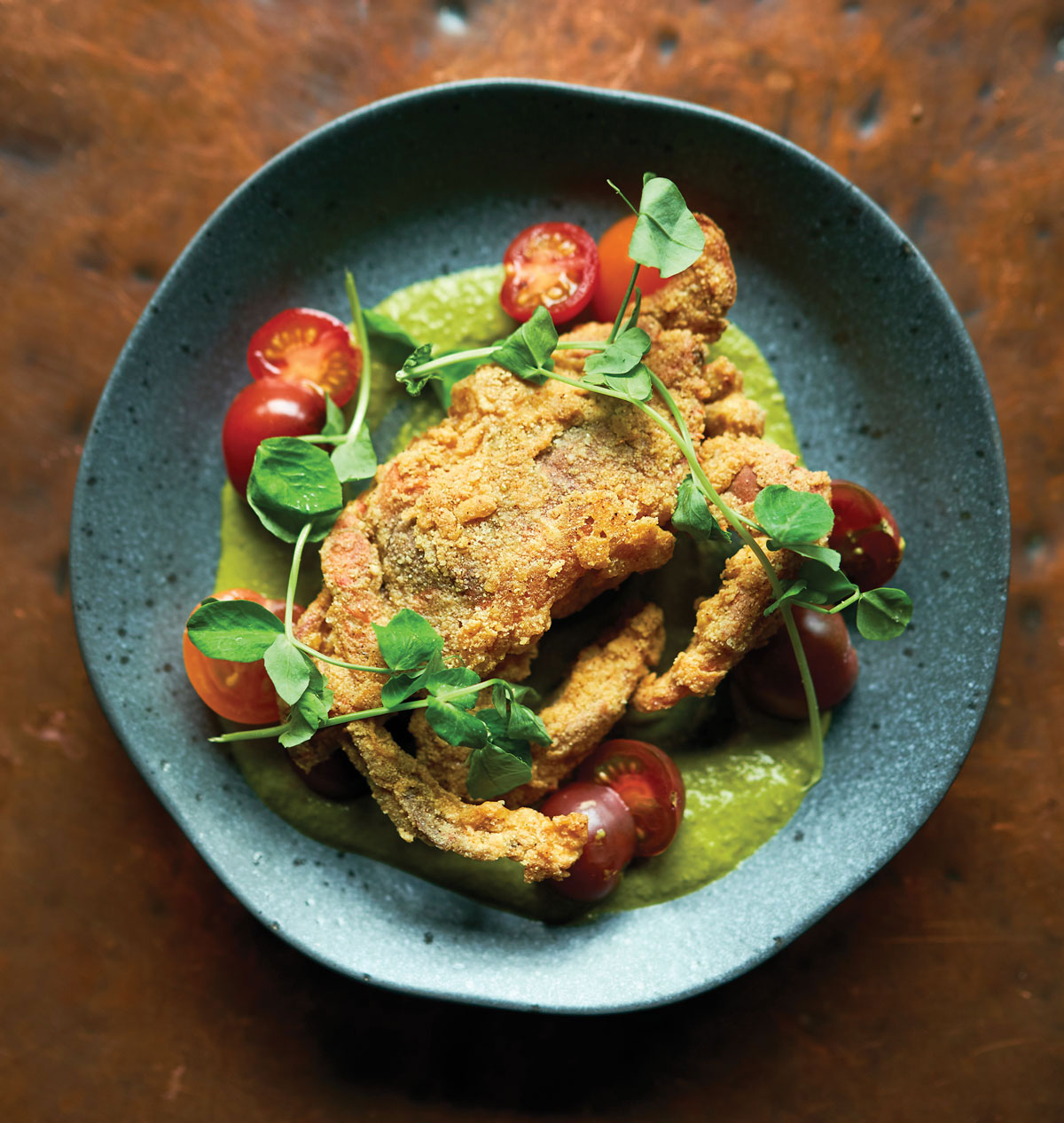
FOR THE CRAB
8 soft-shell crabs
2 eggs
2¼ cups buttermilk
2¼ cups heavy cream
1½ cups masa harina
1 teaspoon salt, plus more for seasoning
½ teaspoon black pepper
canola oil, for pan-frying
FOR THE MOLE VERDE
4 tomatillos, husked and quartered
4 jalapeños, ribs and seeds removed, minced
1 Spanish onion, small dice
6 Boston lettuce leaves
2 tablespoons pumpkin seeds or sunflower seeds
1 tablespoon dried epazote leaves
1 tablespoon dried marjoram
1 teaspoon whole cumin seed
1 cup vegetable stock
¼ cup masa harina
¾ cup fresh cilantro, stems and leaves
1½ teaspoons salt
TO MAKE THE CRABS
Kill the crabs using your preferred method (or pay a visit to YouTube to learn a few simple and humane techniques). Clean the crabs by using sharp kitchen shears to remove the tips of the claws and the sharp points on either side of the body. Carefully pull back the shell on either side to expose the gills. Clip those as well.
In a large bowl, whisk together the eggs, buttermilk, and heavy cream. Add the crabs to the mixture and soak overnight in the refrigerator.
Preheat the oven to 450 degrees. Remove the crabs from the liquid and pat lightly with a clean towel to make them tacky but not dry. Combine the masa, salt, and pepper in a medium bowl. Dredge the crabs thoroughly in the mixture, tapping off the excess.
Heat ½-inch of oil in a 12-inch pan over medium heat to 325 degrees. Add four dredged crabs to the pan, shell side down, and fry for 2 minutes. Flip and fry for 1 minute. (If you have a splatter screen, place it over the pan when you flip the crabs. They’ve been known to explode at this point, threatening bystanders without discretion.)
Transfer the crabs to a baking sheet and sprinkle with salt. Repeat with the four remaining crabs.
Transfer the baking sheet to the oven and bake for 4 minutes. Serve immediately on a bed of wilted greens or grits with mole verde.
TO MAKE THE VERDE
Cook the tomatillos, jalapeños, and onions in the oil over low heat in a heavy-bottomed pot, stirring occasionally, until soft (12–15 minutes). Add the lettuce, seeds, epazote, marjoram, cumin, and stock. Stir to combine. Bring to a simmer and cook 5 minutes. Remove to the bowl of a blender, add the masa, cilantro, and salt. Puree until smooth. Serve immediately or let cool to room temperature and refrigerate for up to 5 days.









